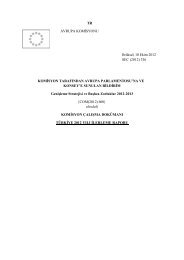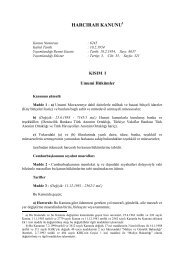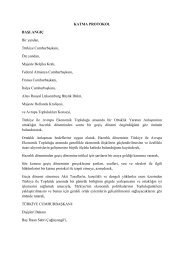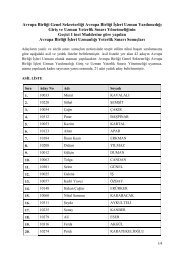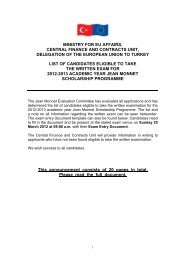2010 ilerleme raporu - Avrupa BirliÄi BakanlıÄı
2010 ilerleme raporu - Avrupa BirliÄi BakanlıÄı
2010 ilerleme raporu - Avrupa BirliÄi BakanlıÄı
Create successful ePaper yourself
Turn your PDF publications into a flip-book with our unique Google optimized e-Paper software.
in the first half of 2009, economic growth resumed in the second half and then gained pace in<br />
the first half of <strong>2010</strong> recouping the output lost in 2009. Domestic demand drove the fastest<br />
expansion in almost six years. Real GDP increased in the first half of <strong>2010</strong> by 11% from a<br />
year earlier, up from 2% in the second half of 2009, reflecting a very significant recovery over<br />
the last year. All sectors demonstrated strong positive growth: trade, industry and construction<br />
expanded by over 15% in the first semester of <strong>2010</strong>. Domestic demand and in particular<br />
investment were particularly strong, as the year-on-year growth in gross fixed capital<br />
formation amounted to a sheer 22%. The high growth in domestic demand translated into<br />
imports growth amounting to 20%. Net exports pulled down the growth performance by<br />
3.4%. Consumer and corporate loans have maintained their rapid pace and continue to spur<br />
domestic demand. High frequency indicators point at a growth slowdown – albeit gradual and<br />
from very high levels – starting in mid-<strong>2010</strong>. Overall, the Turkish economy has demonstrated<br />
high resilience. It is recovering rapidly from the crisis and growing at robust rates since mid-<br />
2009.<br />
Pressures on the current account – which had seen a major crisis-led improvement – started in<br />
late 2009, as robust domestic demand and higher energy prices fuelled imports, which<br />
increased by 30% in the first half of <strong>2010</strong>. In tandem with the rise in imports, exports<br />
performed relatively well and rose by about 15% in the first six months of <strong>2010</strong>.<br />
Consequently, the trade deficit more than doubled passing from 3% of GDP in the first half of<br />
2009 to 6.2% of GDP in the same period in <strong>2010</strong>. The current account balance broadly shows<br />
similar patterns and the deficit is widening rapidly. In the first six months of <strong>2010</strong>, the deficit<br />
amounted to 6.2% of GDP, compared with 2.7% in the same period of 2009. Total financing<br />
needs have almost doubled in <strong>2010</strong>. The financing has been shifting dramatically towards<br />
more portfolio and in particular more cross-border credits to domestic banks (covering two<br />
thirds of the current account deficit) and less direct investment. Reserves rose by about €4<br />
billion to roughly €40 billion. The gross external debt stock amounted to 37% of GDP in the<br />
first half of <strong>2010</strong>, down by about five percentage points from the same period in 2009. About<br />
two thirds is held by the private sector. Overall, external imbalances and financing needs have<br />
been growing significantly on the back of high domestic growth. Access to external finance<br />
remained unproblematic.<br />
In 2009, the unemployment rate amounted to 14%. In tandem with the recovery, the<br />
unemployment rate declined to 11% by mid-<strong>2010</strong> from 13% in mid-2009. The non-farm<br />
unemployment rate, which stood at 17% in mid-<strong>2010</strong>, showed a broadly similar downward<br />
trend. The youth unemployment rate dropped faster, most likely due to the priority given to<br />
this segment in the employment package, to 20% from over 24% in July last year.<br />
Employment data show a marked improvement, as the number of employed increased by over<br />
1,000,000 compared with July last year. The employment rate went up from 42% in mid-2009<br />
to 44% in the same period of <strong>2010</strong>. Female labour participation increased by over 1.5<br />
percentage points since mid-2009, but female employment remains particularly low, at just<br />
half the overall rate. The prevalence of undeclared work remains a crucial issue (See Chapter<br />
19: Social Policy and employment). Given the high unemployment rate and the annual growth<br />
rate of 1.2% in the working-age population, the labour market needs to absorb not only the<br />
unemployed but also one million new entrants every year. Overly strict employment<br />
protection discourages employers from hiring new people. Overall, the unemployment rate<br />
remains higher than pre-crisis and demographic factors are expected to keep unemployment<br />
high in years ahead in the absence of additional labour market reforms and the application of<br />
an appropriate combination of flexibility and security.<br />
EN 39 EN





